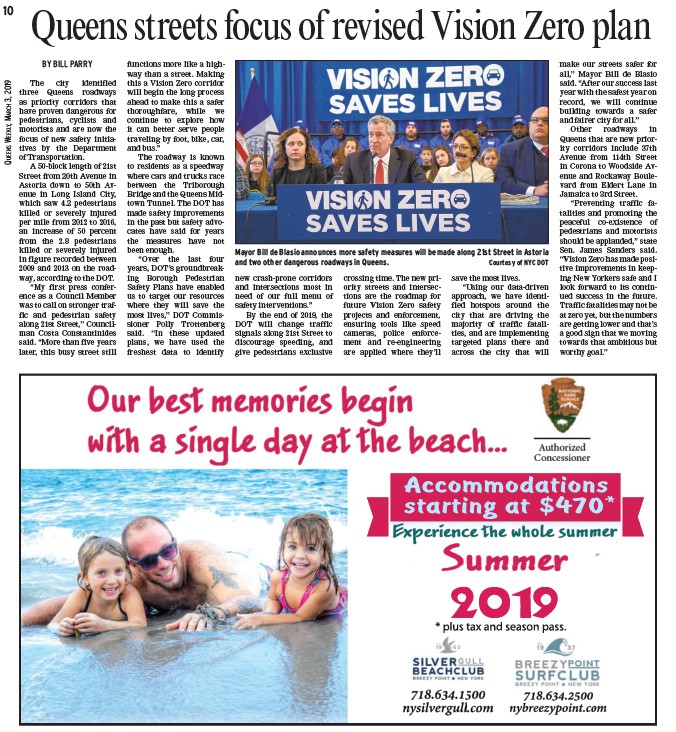
10
QUEENS WEEKLY, MARCH 3, 2019
Queens streets focus of revised Vision Zero plan
2019 * plus tax and season pass.
BY BILL PARRY
The city identified
three Queens roadways
as priority corridors that
have proven dangerous for
pedestrians, cyclists and
motorists and are now the
focus of new safety initiatives
by the Department
of Transportation.
A 50-block length of 21st
Street from 20th Avenue in
Astoria down to 50th Avenue
in Long Island City,
which saw 4.2 pedestrians
killed or severely injured
per mile from 2012 to 2016,
an increase of 50 percent
from the 2.8 pedestrians
killed or severely injured
in figure recorded between
2009 and 2013 on the roadway,
according to the DOT.
“My first press conference
as a Council Member
was to call on stronger traffic
and pedestrian safety
along 21st Street,” Councilman
Costa Constantinides
said. “More than five years
later, this busy street still
functions more like a highway
than a street. Making
this a Vision Zero corridor
will begin the long process
ahead to make this a safer
thoroughfare, while we
continue to explore how
it can better serve people
traveling by foot, bike, car,
and bus.”
The roadway is known
to residents as a speedway
where cars and trucks race
between the Triborough
Bridge and the Queens Midtown
Tunnel. The DOT has
made safety improvements
in the past but safety advocates
have said for years
the measures have not
been enough.
“Over the last four
years, DOT’s groundbreaking
Borough Pedestrian
Safety Plans have enabled
us to target our resources
where they will save the
most lives,” DOT Commissioner
Polly Trottenberg
said. “In these updated
plans, we have used the
freshest data to identify
new crash-prone corridors
and intersections most in
need of our full menu of
safety interventions.”
By the end of 2019, the
DOT will change traffic
signals along 21st Street to
discourage speeding, and
give pedestrians exclusive
crossing time. The new priority
streets and intersections
are the roadmap for
future Vision Zero safety
projects and enforcement,
ensuring tools like speed
cameras, police enforcement
and re-engineering
are applied where they’ll
save the most lives.
“Using our data-driven
approach, we have identified
hotspots around the
city that are driving the
majority of traffic fatalities,
and are implementing
targeted plans there and
across the city that will
make our streets safer for
all,” Mayor Bill de Blasio
said. “After our success last
year with the safest year on
record, we will continue
building towards a safer
and fairer city for all.”
Other roadways in
Queens that are new priority
corridors include 37th
Avenue from 114th Street
in Corona to Woodside Avenue
and Rockaway Boulevard
from Eldert Lane in
Jamaica to 3rd Street.
“Preventing traffic fatalities
and promoting the
peaceful co-existence of
pedestrians and motorists
should be applauded,” state
Sen. James Sanders said.
“Vision Zero has made positive
improvements in keeping
New Yorkers safe and I
look forward to its continued
success in the future.
Traffic fatalities may not be
at zero yet, but the numbers
are getting lower and that’s
a good sign that we moving
towards that ambitious but
worthy goal.”
Mayor Bill de Blasio announces more safety measures will be made along 21st Street in Astoria
and two other dangerous roadways in Queens. Courtesy of NYC DOT